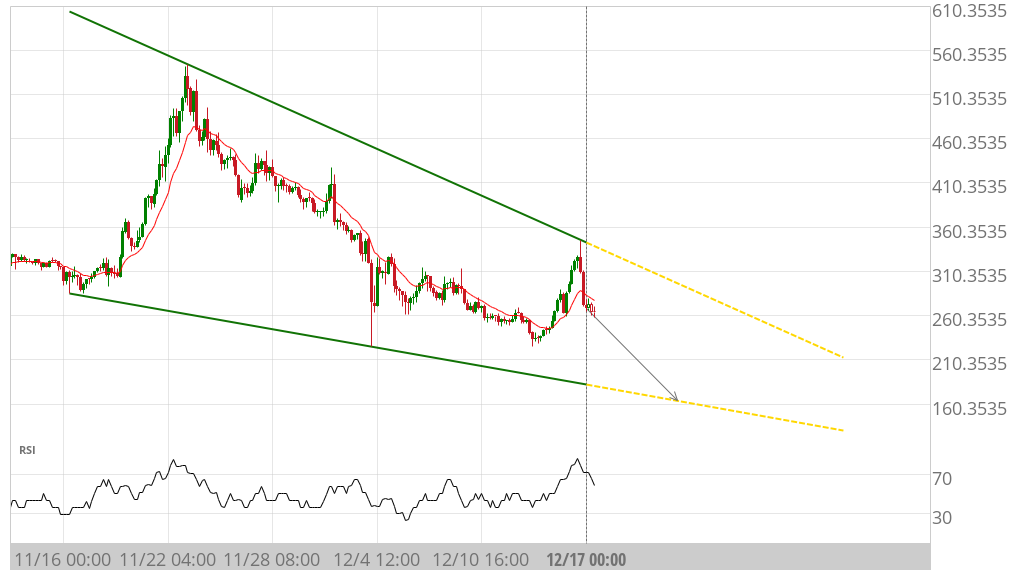Elrond (EGLD) Analysis
In addition to automated chart patterns, altFINS’ analysts conduct technical chart analyses of top 30 cryptocurrencies. We call these Curated Charts and they evaluate 5 core principals of technical analysis: Trend, Momentum, Patterns, Volume, Support and Resistance.
Elrond (EGLD) chart pattern: 4 hours interval
EGLD / USDT Price 266.52 USDT (0.78%)
Falling Wedge: 16 hours ago Profit potential (Sell) +16.39%
Falling Wedge identified at Dec 17, 0:00 UTC. This pattern is still in the process of forming. Possible bearish price movement towards the support 225.2119 within the next 10 days.

What is Elrond (EGLD)?
Find full description and news on altFINS platform.
Overview
Elrond is a blockchain designed for high throughput and relatively fast execution speed compared to other smart contract platforms. It features Adaptive State Sharding as its scaling solution and a Proof-of-Stake (PoS) variation called Secure PoS to secure the network. Elrond also contains a WebAssembly-based virtual machine that can support the creation and execution of decentralized applications (dApps).
History
Elrond is a new blockchain architecture, designed for high throughput and fast execution speed. To achieve this, Elrond introduces two key features: an Adaptive State Sharding mechanism, and a Secure Proof of Stake (PoS) algorithm, which aims to enable linear scalability. The team says its smart contract platform can process upwards of 15,000 transactions per second, with six-second latency and low transaction costs, yet aims to remain permissionless, borderless, and globally accessible. Elrond is built by a team of entrepreneurs, along with 13 engineers and researchers who have worked at various tech companies, such as Microsoft, Google, Intel, and NTT DATA, and have experience working with blockchain platforms. The team includes two PhDs in CS and AI, multiple math, CS, and AI Olympiad champions, and a former member of the NEM core team.
Technology
Elrond architecture rests on the following key innovations: Adaptive state sharding: transaction, data & network sharding with an adaptive mechanism for shard merges and splits that takes into consideration both the available nodes/validators but also the network usage Secure Proof of Stake (SPoS): enables a consensus on block production in two communication rounds with modified Boneh–Lynn–Shacham (“BLS”) multi-signatures among the randomly sampled validators of the consensus group Additional features include: Elrond manages malicious attacks via intra-shard and cross-shard node reshuffling. Nodes inside the shard are randomly selected in the consensus group without the possibility of knowing the members more than a round in advance. Every epoch up to 1/3 of the nodes in every shard is reshuffled to other shards in order to prevent collusion. Secure randomness beacon with BLS signing makes the randomness source unpredictable Elrond balances smart contracts in shards, enabling it to run multiple SCs in parallel, while the cross-shard calls are handled through an asynchronous cross-shard execution model Fast finality for cross-shard transactions. Elrond attempts to accomplish this through the dispatching algorithm (when the decision is made) and the routing protocol (where should the transaction be executed).
Governance
At the moment, the Elrond Network (the company that built the protocol) manages protocol improvements and upgrades. Network participants and validators and can still contribute to any changes or proposals since the codebase is open source. Elrond eventually plans to transition to an on-chain governance model. This on-chain voting system is still in development, although the team plans to release more details on it at some point in Q1 2021.